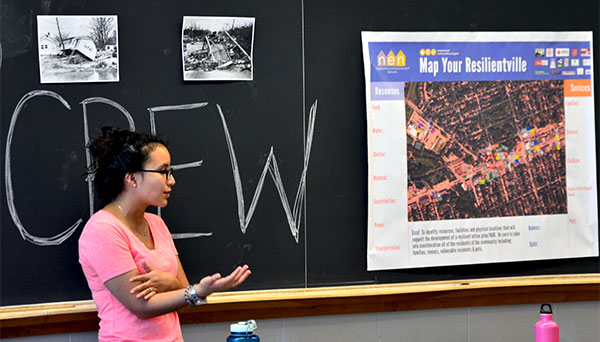Community-led Climate Solutions for Vertical Communities
Organization: The Toronto Environmental Alliance (TEA)
The organization works to build a greener city for all, and is recognized Canada-wide for its municipal work on climate change, waste and initiatives to advance environmental justice.
Location: St James Town, Toronto, Ontario
Country: Canada
Other Organizations Involved: Community Resilience to Extreme Weather (CREW)
 ©Community Resilience to Extreme Weather (CREW)
©Community Resilience to Extreme Weather (CREW)
Background
Toronto is increasingly experiencing climate-related extreme weather events such as heat waves, flooding, and ice storms, which disproportionately impact vulnerable and marginalized residents.
Over half of Toronto households live in multi-residential buildings, including significant populations of tower residents who are racialized, newcomers, low-income, seniors, and people with disabilities. The physical structure of tower buildings, and tenant-landlord relationships, can mean that residents have limited control over their indoor environment (e.g. cooling during a heat wave) and can face life threatening accessibility barriers (e.g. getting to a place of safety during a power outage).
TEA’s and CREW’s past work has demonstrated that tower buildings can become places of community, where teams of residents work together to develop customized solutions for their buildings. Towers can become vibrant “vertical communities”.
Goals
- Work with local volunteer leaders to co-create and implement a community-led emergency response model for extreme weather events, focused on supporting vulnerable residents in tower buildings
- Tangibly demonstrate how impacted residents can play a lead role in building greater community climate resilience
Main activities
- Hold workshops with local volunteers and other stakeholders to develop draft plans and protocols, and a model of community-led emergency preparedness and response model for vertical communities
- Train and support local volunteer leaders and building volunteers to develop and implement of climate emergency preparedness measures for their buildings
- Collaborate with local volunteers to develop narratives linking equity, climate and community-building in vertical communities, produce digital stories featuring local volunteers, and provide media coaching and linking
- Develop and implement a knowledge-sharing strategy to engage stakeholders from Toronto and other municipalities in project learning
Outcomes
- A community-led emergency preparedness and response model for vertical communities will be co-created – including roles and responsibilities of local stakeholders, and plans and protocols to support vulnerable residents during extreme weather events
- A core group of volunteers will be trained to lead emergency outreach during a specific extreme weather scenario, and will recruit 80 volunteers to conduct resident outreach in 4 tower buildings
- 4 project buildings will have emergency response and preparedness plans in place for extreme weather events
- New climate solutions narratives that centre the voices of directly impacted communities will be told through digital stories featuring local volunteers from vertical communities
- 200 stakeholders from Toronto and other municipalities, 20+ additional multi-residential buildings, will be directly engaged in project learning through a knowledge-sharing strategy focused on how this model can be customized and scaled to other settings